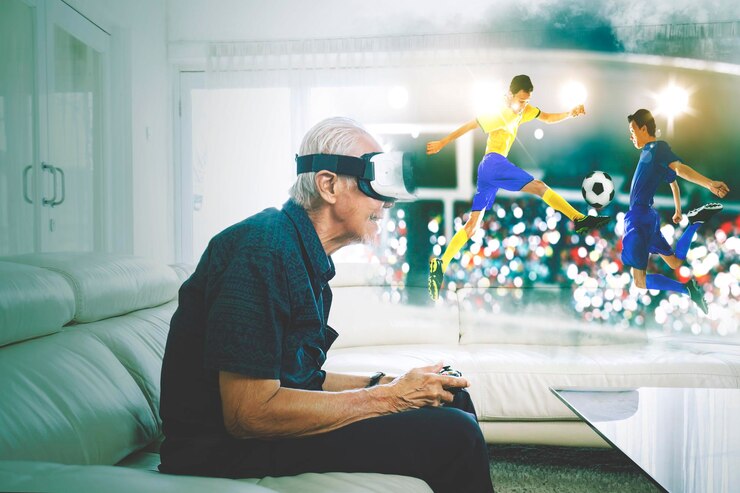
The world of sports gaming has come a long way since its humble beginnings in the arcades. From pixelated representations to hyper-realistic simulations, sports games have evolved with technology, offering immersive experiences for players and fans alike. In this blog post, we’ll explore the exciting journey of sports in gaming, highlighting key milestones from arcade classics to the cutting-edge virtual reality (VR) experiences of today.
The Early Days: Arcade Sports Games
The history of sports in gaming dates back to the 1970s, with the first notable title being Pong (1972), which, while not a direct sports simulation, introduced the idea of competitive play with simple tennis mechanics. Soon after, developers began creating sports games that mirrored real-life activities, though with very basic graphics and controls. Games erone like Track and Field (1983) and Pole Position (1982) brought classic sports like athletics and racing into the gaming world, offering players a chance to experience the thrill of competition in a virtual environment.
The 90s: Rise of Sports Simulations
The 1990s saw a massive leap forward in sports gaming, largely due to the increasing power of home consoles and PC hardware. Sports simulations became more realistic, with games like FIFA and Madden NFL leading the way. These titles introduced detailed player models, realistic gameplay, and strategies that mirrored their real-world counterparts. The emphasis shifted from simple arcade mechanics to a more authentic experience, where fans could control teams, players, and entire leagues. These games were no longer just about fun but about delivering an experience that made players feel like they were on the field or court.
The 2000s: Online Play and Expanding Worlds
With the rise of the internet and broadband connections, the 2000s brought a new dimension to sports gaming—online multiplayer. Titles like FIFA and NBA 2K began to integrate online modes, allowing players to compete against others around the world. This added a new layer of competition and strategy, as players not only had to master the game mechanics but also develop their skills to face global opponents.
At the same time, sports games began to feature larger, more immersive worlds. EA Sports introduced open-world elements, while games like Tony Hawk’s Pro Skater gave players the freedom to explore vast environments. The integration of motion controls with consoles like the Nintendo Wii also introduced a more physical aspect to gaming, allowing players to engage in activities like tennis, golf, and even boxing with more physical interaction.
The 2010s: Hyper-Realistic Graphics and AI
As technology progressed further, sports games took a leap in terms of graphical fidelity and artificial intelligence (AI). The 2010s saw sports games achieving near photorealism, with titles like FIFA and NBA 2K showcasing incredibly lifelike player models, stadiums, and crowd animations. The gameplay mechanics also became increasingly sophisticated, thanks to advanced AI that could replicate real-world player behavior, making each match feel unique and unpredictable.
Games also incorporated more detailed physics engines, which allowed for a more realistic experience. The ball would behave differently depending on weather conditions, player actions, or even the stadium’s size and crowd atmosphere. The introduction of virtual stadiums and improved AI meant that sports games could replicate the excitement and unpredictability of real-world events more convincingly than ever before.
The 2020s: Virtual Reality and the Future of Sports Gaming
Today, the evolution of sports gaming has entered the realm of virtual reality (VR). With VR technology, players can experience sports games in a whole new way—by stepping directly into the game. VR allows for a completely immersive experience, where players can interact with the environment and players as if they were physically on the field. VR sports games like Beat Saber (a rhythm-based game) and VR Sports Challenge offer a range of sports activities, from basketball to football, providing an engaging and hands-on experience.
The potential of VR in sports gaming is still expanding. It promises to bridge the gap between physical sports and virtual gaming, offering a workout while having fun. Furthermore, the integration of augmented reality (AR) and advanced motion capture technology could take sports simulations to a whole new level, making them even more interactive and realistic.
Conclusion
From its early days in arcades to the immersive VR experiences of today, sports gaming has evolved dramatically. What started as simple pixelated representations of sports has transformed into highly detailed and immersive simulations that allow players to experience the thrill of competition in ways that were once unimaginable. As technology continues to advance, we can expect even more innovations in the world of sports gaming, from deeper AI to more realistic VR experiences, shaping the future of how we interact with our favorite sports—both virtually and in the real world.